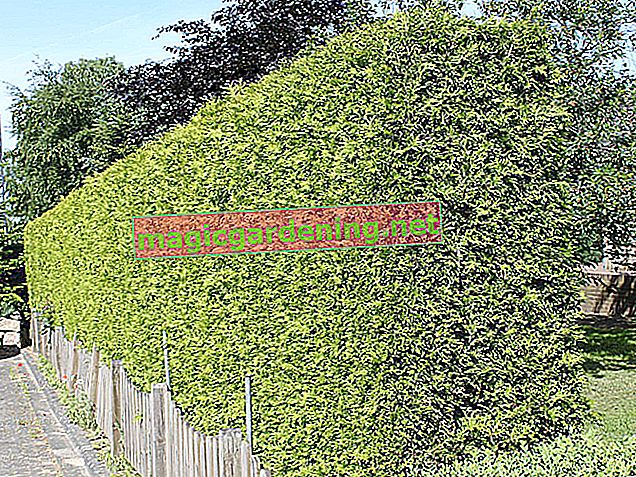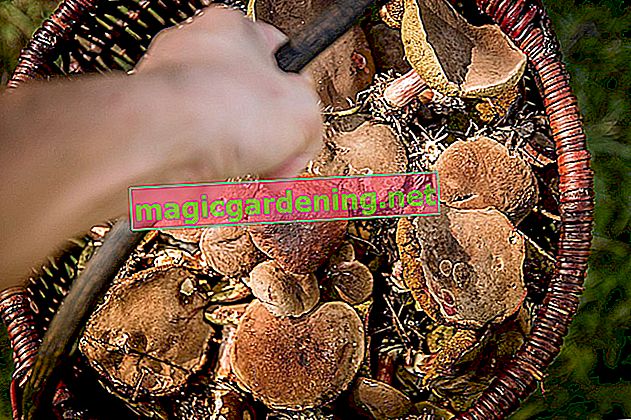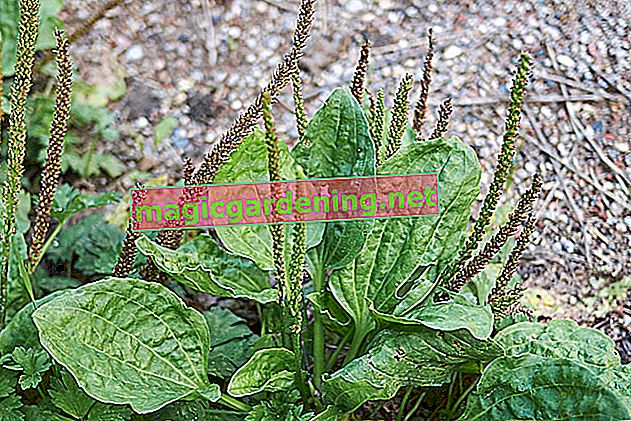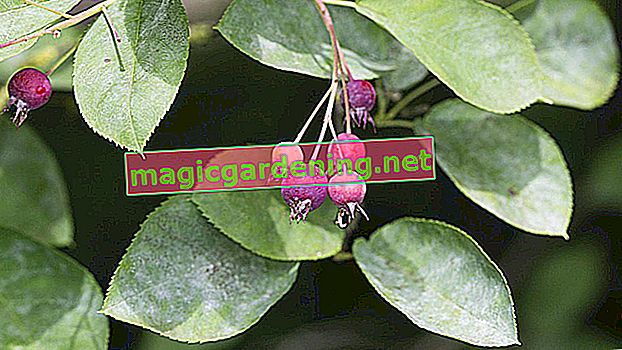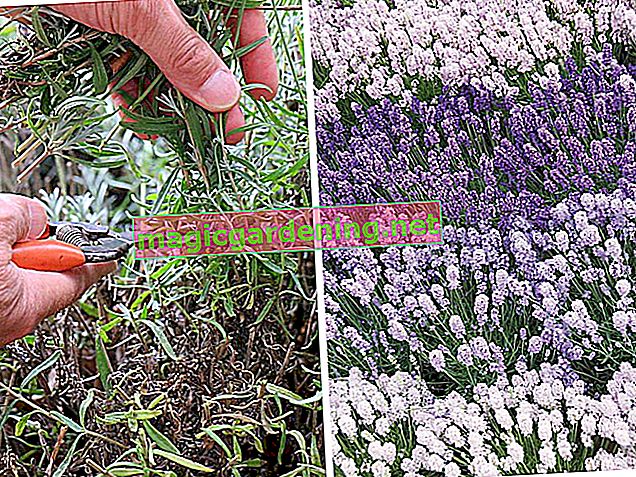
Why does it make sense to cut farm hydrangeas?
Home gardeners are uncertain about the correct pruning of farm hydrangeas. The pruning care is often canceled entirely out of concern that the nostalgic beauties of the flowers will be damaged. In fact, the secateurs should be used at least once a year. The following table documents as a brief overview when a cut on Hydrangea macrophylla is advisable:
also read
- Farm hydrangea blooms all summer
- Farm hydrangea does not bloom - why is it?
- Only if it is absolutely necessary: transplant farm hydrangea
| Cut type | Goal / occasion |
|---|---|
| Structure and education cut | controlled growth in the bucket or if there is a lack of space |
| Clearance cut | Favoring vitality and flowering |
| Taper cut | revitalize old shrub |
| Conservation cut modern varieties | Cut care from Endless summer and Co. |
Another cutting option is out of the ordinary in terms of date and procedure. We are talking about the vase cut of peasant hydrangeas to decorate the home with their huge flower balls. This tutorial leaves no questions unanswered for this cut variant either.
The best cut date is in spring
A farmer's hydrangea already laid out its plants for next year's flower festival last year, including the leaf and shoot buds. This property significantly influences the choice of date for a cut. Spring is the best time to ensure that the valuable buds do not fall victim to the scissors. Shortly before budding between early / mid-February and early March, even house gardeners with little experience can clearly identify the terminal flower arrangements and exercise appropriate caution when cutting.
Tips
In gardens with a risk of late ground frost, the prudent home gardener has a garden fleece ready until mid / end of May. If meteorologists report frost at night, a farm hydrangea should be protected from frostbite at the shoot tips. This is especially true if the ornamental shrub has been cut.
Construction cut - disciplined growth in the tub or small garden
If a farmer's hydrangea has at least 150 centimeters of space available, a harmonious structure naturally develops. In the small garden or tub there is the option of aligning the growth with the lack of space from the start. You can do this by limiting the number of ground shoots in an upbringing. How to do it right:
- During the first 3 to 4 years of standing in the bed, build a frame with 10 to 15 soil shoots
- Raise 7 to 10 scaffolding shoots in the bucket
- Cut off excess ground shoots at the base
In the build-up phase, the annual, unbranched ground shoots remain uncut because they bear the most beautiful flowers in summer. In the spring of the fourth year at the latest, the upbringing ends in the following cut. Please note that a farmer's hydrangea is not suitable for raising a standard tree. The much more pruning-compatible panicle hydrangeas (Hydrangea paniculata) are predestined for this design form.
Careful cutting is the key - instructions for the thinning cut
A single ground shoot of your farmer's hydrangea remains vital and willing to flower for up to 4 years. During this phase and afterwards it branches out noticeably, the flowers lose their volume and the branch hangs arching down to the ground. You can counteract this development with a gentle pruning, so that the flowering bush will still thrive young and lively even after many years. This is how the exemplary clearing cut succeeds:
- Cut off all withered flower heads
- Place the scissors over the new, round, thick flower buds
- Cut away a quarter of the oldest scaffolding shoots at floor level
- Leave a corresponding number of annual ground shoots as a substitute uncut
- Remove weak, inward or cross-growing ground shoots
In the last step of the clearing cut, dedicate yourself to the remaining three quarters of the scaffolding shoots. By the age of 2 to 4 years they have already flowered at least once and developed multiple branches. You derive an aging hydrangea branch from the most promising, annual side shoot. With this cutting technique, you cut off the old wood at the branch of the young shoot. The figure below illustrates the various steps involved in a clearance section.

Rejuvenate old farm hydrangeas - this is how it works
Without a regular clearing cut, farm hydrangeas age within a few years. With a rejuvenating cut, you can wake the aging ornamental shrub from its slumber. The following strategy has worked well in practice:
- Thoroughly examine the bush for overwintering wild animals and cut them later if necessary
- According to the Federal Nature Conservation Act, carry out the cutting measure before March 1st
- Cut off all bald shoots at ground level
- Cut back non-balding shoots by one to two thirds
- Place the scissors 0.5 cm above a pair of leaves or a sleeping eye
- Enrich the root disc with 3 liters of compost and 100 grams of horn shavings per square meter
There is nothing to worry about if a rejuvenating cut leaves few or no shoots. The organic fertilizer and regular watering get growth going again. In the following year you switch to the structure or clearance section. If, despite your efforts, no new ground shoots form, the farmer's hydrangea is completely exhausted and should be cleared.

Special case: Endless summer & Co. - courageous maintenance cut
Competent growers have succeeded in growing modern farmer hydrangea varieties that bloom on both last year's and this year's shoots. The 'Endless summer' series opened the ranks of new varieties, followed by further innovations such as 'Forever & Ever', 'Everbloom' or 'Double Star'. The more flexible growth behavior opens up more leeway in the design of the pruning, as the figure below shows.
It is your horticultural decision to shorten new varieties of farmer's hydrangeas more in the spring. This is especially recommended if a severe winter or late frosts have damaged the shoots. At the age of 3 to 4 years, ground shoots should be thinned out to make room for fresh wood. Wilted inflorescences should also be trimmed every spring on the new varieties to make it easier for the new buds to develop.

Summer cleaning is rewarded with re-flowering
Endless summer and other modern strains have the potential to re-bloom. If you clean out the first flower pile after it has faded, these farm hydrangeas will produce beautiful flowers again. Combine this flower care with the addition of compost and horn shavings, (€ 6.39 at Amazon *) you optimize the prospects for a colorful second bloom in late summer.
Farmer hydrangeas cut for the vase - this is how it works
The right time to cut the vase guarantees that the beautiful branches of a farmer's hydrangea will decorate your home for many weeks. If you cut the shoots too early or put the woody stems in the water unprocessed, the romantic beauties will sadly hang their heads after a few days. How to do it right:
- The best time is in August when the flowers are firmer
- Cut out a maximum of one third of the shoots from a hydrangea bush
- Place scissors or a knife over a pair of leaves or a sleeping eye
- Cut the green end of the stem diagonally, split the woody stem end
- Remove any leaves that might be in the water
Please do not tap a woody flower stem with a hammer to make it softer. This destroys the important conduction pathways that are supposed to transport the water into the flower. Replace the water every 3 to 4 days and use this opportunity to trim the stems.
frequently asked Questions
Frost damage to my farm hydrangea - what to do?
A harsh winter puts every farm hydrangea to the test, because the younger shoot tips in particular are not completely hardy. If the branches freeze back, this is no reason to clear the affected ornamental shrub. When you realize the full extent of the frost damage at the end of February / beginning of March, cut the brown discolored, often limp shoots back into the healthy wood. Place the scissors just above a healthy pair of buds.
How can you tell whether a hydrangea branch has died or not?
Lignified hydrangea shoots cannot always be seen at first glance whether they belong to dead wood or whether there is still hope of sprouting. Clear any doubts out of the way with a simple vitality test. To do this, scrape off a little bark from the hydrangea branch in question. If juicy green tissue appears, the shoot is spared from the scissors. Yellowish to brown tissue indicates that the branch has died and can be thinned out.
The withered flowers bothers me. Can I clean out a farm hydrangea in autumn?
It is up to you to decide when to remove the withered inflorescences of a farm hydrangea. If you find the brown, parchment-like balls annoying, cut them off just above the next healthy pair of buds or a branch. You then carry out the actual clearing cut as planned in February. You can use this opportunity to remove damaged shoot tips that have had to forego the natural winter protection of withered hydrangea flowers and have frozen back.
Are farm hydrangeas poisonous?
All hydrangea species contain the glycoside hydrangin and other toxins. Intentional or unintentional ingestion of parts of plants can lead to typical symptoms of poisoning, ranging from dizziness to nausea and vomiting. Frequent contact with the sap can also cause skin allergies. Hydrangeas are not only poisonous for humans, but also for animals such as dogs, cats, guinea pigs and rabbits.
The 3 most common mistakes
If the cut on farm hydrangeas does not lead to the desired result, the gardener has become the victim of a misunderstanding. The 3 most common mistakes when cutting farmer's hydrangeas are named in the following table with tips for effective prevention:
| error | result | Prevention / Correction |
|---|---|---|
| Farmer's hydrangea cut like panicle and ball hydrangea | Failure of the next flowering period | Just clean and thin out the farmer's hydrangeas |
| cut in autumn | Frost damage to the unprotected shoot tips | ideally cut in spring |
| never worn out and exposed | Hydrangea that had aged prematurely with sparse growth and few flowers | remove dead blossoms every year and remove dead wood |
Tips
This tutorial also applies to the plate hydrangea (Hydrangea serrata), the velvet hydrangea (Hydrangea sargentiana), the oak leaf hydrangea (Hydrangea quercifolia) and the popular climbing hydrangea (Hydrangea petiolaris). These hydrangea species do the same as the farm hydrangea. In the previous year you were already laying out all types of buds for flowers, leaves and fresh shoots.



